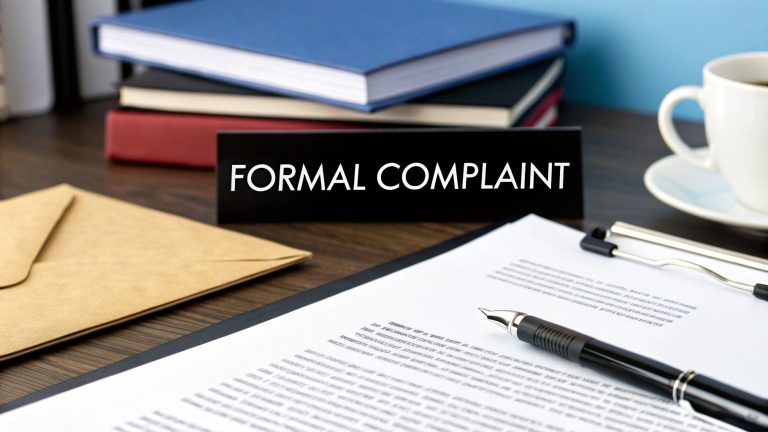Learning how to write a complaint letter can feel daunting. You might worry about sounding too harsh or missing a key detail. But a clear, concise message often drives the best results. Nearly one in four U.S. employees report witnessing unethical behavior at work in the past year (Hiration). So you’re not alone in wanting to raise a concern.
In this tutorial, you’ll get step-by-step guidance to draft a professional complaint letter, present your case firmly, and increase the odds of a positive response.
1. Define your objective
What outcome are you hoping for? Do you want a refund, a policy change, or a formal apology? Pinpointing your goal keeps your message focused and actionable.
Identify core concern
Start by writing a one-sentence summary of the issue. For example, “I would like to file a complaint about unsafe lab practices in my department.” That single line becomes your north star as you build the letter.
Gather supporting evidence
Having facts on hand shows you’ve done your homework. Breaches of employment contracts accounted for 33 percent of all civil lawsuits in the U.S. last year (Hiration). Jot down any dates, names, policy sections, or photos that back up your claim.
List relevant documents
- Emails or memos
- Photographs or screenshots
- Witness statements
Note key dates
Include the date of the incident, when you reported it verbally, and any other timeline details.
2. Structure your letter
Wondering how to lay it out so it reads like a pro? Stick to a standard business letter format (block style). Use a simple font like Arial or Times New Roman, size 11 or 12, with 1-inch margins.
Use a professional format
A clean format shows you mean business. Align all text to the left, skip lines between each section, and avoid fancy graphics or colored text.
Add contact information
Start with your details at the top left, then add the date and the recipient’s information. For example:
- Your name
- Street address, city, state, ZIP
- Phone number and email
- Date
- Recipient name, title, and company
- Company address
Write a clear introduction
Open with your purpose in one straightforward sentence. Consider introducing your letter with “I would like to file a complaint regarding…” to make your intent clear from the get-go (Scribendi).
Detail the issue
This is the heart of your letter. Explain what happened, when, and who was involved. Stick to the facts and avoid emotional language.
Stick to relevant facts
Focus on objective details, such as times, dates, and policy references.
Attach supporting documents
Include copies of invoices, contracts, or safety logs that back up your points.
Here is a quick reference table for each section:
| Section | What to include | Purpose |
|---|---|---|
| Contact info | Your name, address, email, phone | Makes it easy to reach you |
| Date | Current date | Shows when letter was sent |
| Recipient info | Name, title, company name, address | Targets the right decision maker |
| Introduction | Reason for writing | Sets focus |
| Body | Issue details | Provides evidence |
| Resolution | Desired outcome | Guides the response |
| Closing | Polite sign-off and signature | Adds professionalism |
| Attachments | Copies of receipts, contracts, or other records | Supports your claims |
Close with next steps
Finish by stating clearly what you expect and by when. A phrase like “I look forward to your response by [date]” sets a polite but firm deadline.
3. Choose your tone
Your tone can make or break the impact of your message. Stay professional and polite, but don’t shy away from firmness.
Stay professional and polite
Use words like please and thank you. That small touch keeps the door open for collaboration.
Avoid accusatory language
Here’s a quick do and don’t list:
| Do | Don’t |
|---|---|
| Focus on facts | Use threats |
| Address the letter to a specific person | Vent frustration |
| Keep sentences short and clear | Accuse without evidence |
Avoid blanket statements like “you always” or “everyone knows.” Stick to what you personally experienced.
4. Specify desired resolution
Now that you’ve made your case, suggest how to make things right. Proposing a fair solution shows you’re seeking a constructive outcome.
Propose a fair solution
You might request:
- A refund or reimbursement
- Policy review or staff training
- A written apology
- Repair or replacement of a product
Set a response timeframe
It’s reasonable to ask for a reply by a certain date. Experts recommend giving 10 to 14 business days and noting you may seek outside help if you don’t hear back (FTC).
5. Polish before sending
A typo or unclear sentence can weaken your message. Take time to make sure everything reads smoothly.
Proofread for clarity
Read your letter aloud. Fix any awkward phrases, check for spelling errors, and confirm all dates and names are correct.
Get a second opinion
Ask a trusted colleague or friend to review your draft. Fresh eyes can catch missing details and spot tone issues. Consider having a third party read it for clarity before sending (Lawdistrict.com).
To wrap up, a well-crafted complaint letter balances clarity, professionalism, and a firm request for action. Follow each step, use precise facts, and maintain a respectful tone. Ready to give it a try? Draft your first paragraph today, and share your experience in the comments so we can all learn together.



